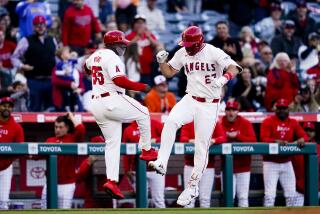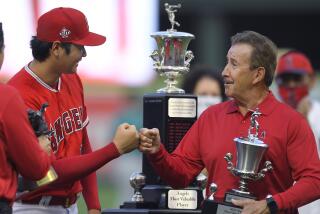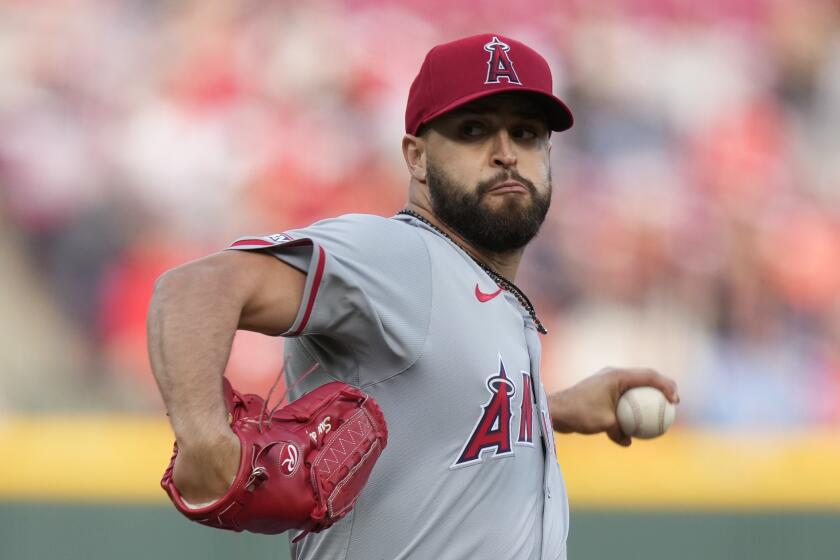Angels Are Going Out of Style
Set upon by three months of hardball imprecision, put there in part by several more months of front-office imprecision, the Angels at their top end -- what they put on the field every night -- appear to have stalled out, like a discarded baseball rolled dead on a damp infield.
In contemplating the Angels’ last-place standing in the American League West, their thready offense (Mike Scioscia prefers “dismal”) and clumsy defense (Scioscia: “unexpected”), it is the analogy that recycles itself.
A cool Chicago night, a playoff game tied in the ninth, a strikeout seemingly bringing extra innings, a reserve catcher tossing a ball toward the pitcher’s mound, and that’s that.
The Angels have lain there since, winless in the final four games of that league championship series, 12 games under .500 since, playing nothing close to the end-to-end game that made them special.
Three wins from the World Series eight months ago, when they still didn’t have a 40-home run guy behind Vladimir Guerrero but managed to play the game anyway, the Angels will go into the All-Star break with the Atlanta Braves and Cleveland Indians as the leading flops in baseball.
So far, Angels fans have been forgiving, turning out even on the nights Jeff Weaver pitched. So, too, has their division been merciful. The first-place Oakland A’s began the weekend at 42-36. Considering the equally pedestrian National League West, it’s a wonder they play the game anywhere left of St. Louis anymore.
This is not what Arte Moreno paid $104 million for, you can be sure of that. Worse, maybe, it’s not what Scioscia stands at the dugout rail expecting to see.
The way it was, most other teams played baseball. His team played baseball.
There’s a difference.
“We didn’t always make the perfect pitch,” Scioscia said. “We didn’t always make the perfect play. We didn’t always do the perfect thing. But we did it at a great percentage.”
Remember that?
For three months, instead, they are exactly as far as their pitching staff has carried them, not the width of one seam further, and that’s a staff that has gone without Bartolo Colon, even when he’s stood on the mound with a baseball in his hand. That’s not the real Colon.
For those who have shrieked about the Angels’ pitiful on-base percentages, their unwillingness to take pitches, their unnecessary daring on the base paths, their misguided affection for the sacrifice bunt -- even as the Angels played into October -- this is your year.
The question now, heading into a week when the Angels play three games in Seattle and four in Oakland, what does General Manager Bill Stoneman do about it?
There are opposing schools of thought here. Both can be found within the organization, and with almost no effort.
* The Soriano Theory. Named for the free-swinging, soon to be free-agent second baseman-outfielder, it says one extraordinary slugger makes everything whole again.
Guerrero sees strikes again. Orlando Cabrera, who has reached base 95 times over 58 games, scores more than 42 times in them. Kendry Morales gets himself a few more months of minor league at-bats.
The misplays and the unearned runs, and the extra pitches thrown by an already burdened pitching staff, won’t necessarily recede. But, by simply becoming an average offensive team, the Angels cover for a rapidly slowing Garret Anderson and an arthritic Darin Erstad, and win more often.
The Angels are at once too young, too old and too imperfect to win. In Wednesday’s loss to Colorado, for instance, they had in their batting order only three players -- Cabrera, Guerrero and Adam Kennedy -- who are both proven and in their primes.
The ideal: Alfonso Soriano, Miguel Tejada, Carlos Lee, Pat Burrell, Carl Crawford.
The cost: Ervin Santana. No general manager worth his behind-the-batting-cage posture would trade a middle-of-the-order hitter for less.
As promising as Jered Weaver is, his stuff does not come close to comparing to Santana’s.
Even then, Stoneman would have to run them off Howie Kendrick, who, as one major league scout said this week, “is a batting title and 20 home runs waiting to happen. I don’t even care about his defense.”
* The Vlad Theory. It’s on him and the pitching. The season falls where it may. Next spring, Casey Kotchman is sound, Jered Weaver is a full-timer, Kendrick is at second base, Erstad is recovered or replaced, maybe both.
The extra offense comes through free agency -- Soriano, Lee, Gary Sheffield, Nomar Garciaparra, Shannon Stewart and Torii Hunter could all be free agents -- and is had for a piece of the profits and a draft pick, not a major prospect or a big league pitcher.
Stoneman has passed on the likes of Troy Glaus and Bengie Molina for his belief in the farm system, and is seeing the erosion of Anderson, Erstad and Tim Salmon. It’s July, and a dependable run producer just ain’t comin’ in. So, the time will come.
Granted, it’s the conservative path, and well worn by Stoneman’s loafers.
“The approach we’re taking is, there’s no cavalry coming,” Scioscia said. Later, he added, “As much as I’ve ever seen him, Bill is exploring alternatives.”
If he finds none, considering what they’ve done in the first half and what the A’s often do in the second half, the Angels will lose. If he wangles Soriano away from Washington, the Angels could lose anyway, both now and in the future.
Gradual attrition -- in the players who left and the game left in those who stayed -- has put them here, unable to sustain through nine innings, unable to cover themselves over six months. Where once they amounted to more than appeared, now they are exactly what they seem.
More to Read
Go beyond the scoreboard
Get the latest on L.A.'s teams in the daily Sports Report newsletter.
You may occasionally receive promotional content from the Los Angeles Times.





